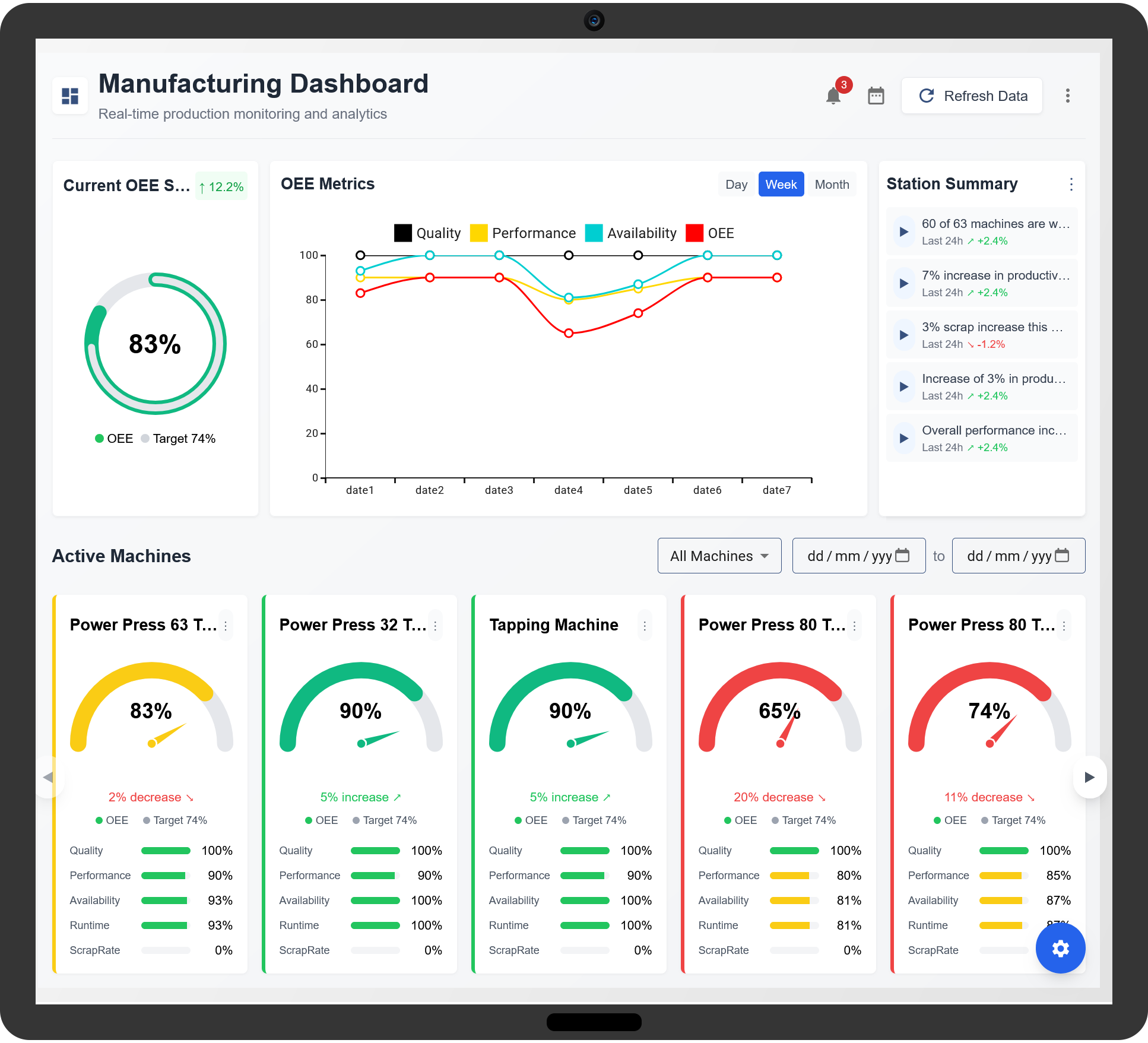Overall Equipment Effectiveness (OEE) is a critical metric in manufacturing that measures the efficiency and effectiveness of equipment. By implementing an OEE system, businesses can identify productivity gaps, minimize downtime, and optimize operations. A well-structured OEE system helps manufacturers enhance production performance and maximize asset utilization.

1. Understanding OEE and Its Components
OEE is calculated based on three key factors:
- Availability: The percentage of planned production time in which the equipment is running.
- Performance: The efficiency of equipment based on its actual speed compared to its maximum potential speed.
- Quality: The proportion of produced units that meet quality standards without defects or rework.
The OEE score is determined by multiplying these three factors:
OEE = Availability × Performance × Quality
An OEE score of 100% means perfect production with no downtime, full-speed performance, and zero defects.
2. How to Identify Productivity Improvement Opportunities with OEE
Step 1: Measure and Track OEE Data
The first step in improving productivity is measuring OEE across all equipment. This requires collecting real-time data on machine uptime, speed, and quality rates. Accurate data collection helps pinpoint inefficiencies and problem areas.
Step 2: Analyze Equipment Downtime
Unplanned downtime significantly reduces OEE. By analyzing downtime causes, such as equipment failures, maintenance delays, or operator inefficiencies, businesses can implement corrective actions to minimize lost production time.
Step 3: Optimize Machine Performance
Performance losses occur when machines run at slower-than-optimal speeds. Identifying slow cycles, frequent stops, and minor breakdowns allows manufacturers to streamline processes and improve cycle times.
Step 4: Reduce Defects and Rework
Quality defects lower OEE and increase production costs. By monitoring defect rates and identifying root causes, manufacturers can implement quality control measures to reduce waste and improve first-pass yield rates.
Step 5: Implement Predictive Maintenance
Regular maintenance ensures that machines run at peak efficiency. Predictive maintenance strategies, such as sensor-based monitoring and data analytics, help prevent unexpected failures and reduce downtime.
Step 6: Standardize Workflows
Inconsistent processes can lead to inefficiencies. Establishing standardized workflows and best practices across production lines ensures uniformity and reduces errors.
3. Best Practices for Maximizing OEE
- Set Realistic OEE Targets: Define achievable improvement goals based on industry benchmarks and current performance.
- Train Employees on OEE Optimization: Educate staff on best practices for maintaining machine efficiency and quality.
- Use Automated Data Collection: Implement real-time monitoring systems to track and analyze OEE metrics accurately.
- Continuously Improve Production Processes: Conduct regular assessments and implement lean manufacturing techniques.
- Foster a Culture of Continuous Improvement: Encourage employees to identify inefficiencies and suggest improvements.
4. The Future of OEE in Manufacturing
With advancements in digital technology, OEE systems are evolving to provide deeper insights into manufacturing performance. Integration with data analytics, artificial intelligence, and automation enhances real-time decision-making and helps businesses achieve higher productivity levels.
By leveraging an OEE system effectively, manufacturers can unlock new productivity opportunities, reduce operational costs, and maintain a competitive edge in the industry.
Find Productivity Improvement Opportunities with Overall Equipment Effectiveness (OEE) system
What is Overall Equipment Effectiveness (OEE)?
OEE is a performance measurement metric used to evaluate the efficiency and effectiveness of manufacturing equipment.
Why is OEE important for productivity improvement?
OEE helps identify inefficiencies, reduce downtime, and improve equipment utilization for higher productivity.
How is OEE calculated?
OEE is calculated using the formula: Availability × Performance × Quality, where each factor measures different aspects of productivity.
What are the key components of OEE?
The three key components of OEE are Availability (uptime), Performance (speed), and Quality (defect-free output).
How does OEE help identify production losses?
OEE highlights downtime, slow cycles, and defects, helping teams focus on areas for improvement.
What are the six big losses in OEE?
The six big losses include equipment failures, setup time, small stops, slow cycles, defects, and startup rejects.
How can OEE data be used to improve efficiency?
By analyzing OEE data, teams can optimize production schedules, reduce downtime, and enhance equipment reliability.
What are the common challenges in OEE implementation?
Challenges include data accuracy, resistance to change, and lack of real-time monitoring.
How often should OEE be monitored?
OEE should be monitored continuously to ensure timely identification of inefficiencies and areas for improvement.
What are the best practices for improving OEE?
Best practices include preventive maintenance, real-time monitoring, and process optimization.
How can OEE be customized for different industries?
OEE can be adapted based on industry-specific production goals, machine types, and efficiency benchmarks.
What tools are used for tracking OEE?
OEE tracking tools include manual log sheets, digital dashboards, and automated monitoring systems.
How does OEE support lean manufacturing?
OEE helps eliminate waste, improve process flow, and maximize resource utilization, aligning with lean principles.
What role does OEE play in predictive maintenance?
OEE data helps predict potential equipment failures, reducing unplanned downtime through proactive maintenance.
How can OEE be integrated with continuous improvement strategies?
OEE data drives continuous improvement by identifying areas for optimization and tracking long-term performance trends.